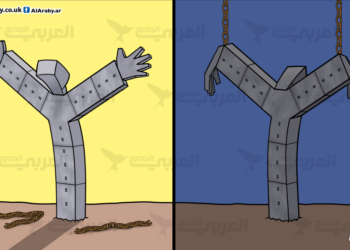The issuance of Legislative Decree No. 16 of 2025 by the Syrian Transitional Government represents a step in the emerging Syrian path toward dismantling the legal framework of systematic confiscation, which was a prominent feature of the Assad regime.
The decree was issued on May 10, 2025, pursuant to Article 48 of the Constitutional Declaration issued on March 13 of the same year, with the aim of revoking all precautionary seizure orders issued between 2012 and 2024. This seeks to address one of the most serious forms of state property rights violations in the history of the modern Middle East.
Data from the Syrian Network for Human Rights indicates that at least 40,602 seizure and confiscation orders have been documented, affecting approximately 320,000 Syrian citizens during this period. This makes this issue a fundamental prerequisite for rebuilding the social contract in post-Assad Syria.
This article divides its analysis into two main axes: the first examines the historical background and legal framework that led to the issuance of this legislative intervention, while the second offers a critical reading of Decree No. 16 in terms of its content and institutional framework, identifying the areas of reform it introduced, as well as the legislative loopholes that hinder the achievement of comprehensive justice.
Part One: The Legal Framework and Historical Context
The Legacy of Legislative Decree No. 63 of 2012: This decree was issued in September 2012, at the height of the Assad regime’s violent crackdown on the popular uprising that began in March 2011. It embodied the transformation of law from a tool of governance to a centralized means of transforming state institutions into an organized mechanism for arbitrary confiscation for political and security reasons, outside any fair judicial framework.
The decree granted the Minister of Finance unprecedented authority to issue precautionary seizure orders based solely on a “reasoned request” from security agencies. This deliberately vaguely worded formula enabled the seizure of the movable and immovable assets of anyone suspected of committing “terrorist crimes” without establishing precise criteria for suspicion or providing guarantees for review, objection, or referral of cases to the judiciary.
This established a systematic violation of the principle of judicial exclusivity in restricting ownership, as the executive authority seized judicial powers without any constitutional mandate or procedural guarantees.
Evidence documented by the Syrian Network for Human Rights (SNHR) report reveals the broad scope of this political exploitation of the law. Between 2012 and 2024, at least 40,602 decisions were issued by the Ministry of Finance regarding the assets and property of Syrian citizens, including freezing movable and immovable assets, precautionary seizure orders, confiscation, and the permanent freezing of bank accounts.
A demographic analysis of the affected population shows that these measures deliberately targeted political opponents, former detainees, the forcibly disappeared, refugees, and internally displaced persons, particularly their family members, in flagrant violation of the fundamental legal principle of individual responsibility enshrined in both the Syrian constitutional tradition and international law.
The Constitutional Basis of Decree No. 16 of 2025
Legislative Decree No. 16 of 2025 derives its mandate from Article 48 of the Constitutional Declaration issued on March 13, 2025, which enshrines the power to repeal laws and their effects, given the systematic nature of legal violations under the previous regime. This requires not only prospective reform but also retroactive redress of accumulated grievances.
The principle of retroactive correction, contained in the decree, is based on the legal principle that “invalid decisions do not have legal consequences and do not require a judicial appeal to invalidate them. Rather, they are revoked by regulatory action immediately upon proof of the reason for invalidity.”
The retroactive effect, as stipulated in the executive provisions of the decree, embodies the principle of direct administrative correction of invalid decisions by nullifying all legal effects arising from the revoked seizure decisions, including the deletion of real estate records, the cancellation of administrative freezes in official records, and the restoration of the legal status of the seized assets to their previous state.
While this principle enjoys legal validity, its practical application faces complex challenges in the context of confiscations that have lasted for more than a decade. Converting precautionary seizures into permanent confiscations, transferring ownership to third parties linked to the former regime or its affiliated militias, and registering property in the name of the state have created complex legal situations that go beyond mere administrative regression.
Therefore, implementing this constitutional principle requires the development of advanced legal mechanisms to address multi-level violations, resolve conflicting claims, and address cases where it is physically impossible to restore rights.
Part Two: Critical Evaluation of the Reform Content and Institutional Gaps
Legislative Decree No. 16 of 2025 reveals a contradictory structure: on the one hand, it recognizes systematic legal violations, while on the other, it limits the scope of redress in ways that limit its reformative impact.
Article 1 explicitly limits cancellation to precautionary detention decisions issued “based on Legislative Decree No. 63 of 2012” without a judicial reference or direct security instructions.
Although this formula addresses the majority of violations, it establishes exceptions that significantly weaken the decree’s reformative effect.
Prominent among these exceptions is the exclusion of judicial detention orders issued by the Public Prosecution, investigating judges, or competent courts, even though many of these were based on the same framework of vague criminalization and political motivations that characterized administrative detention orders.
This exclusion of judicial control poses a profound problem in light of the reality of the Syrian judiciary under Assad’s rule. In many cases, judicial authorities have issued arrest warrants based on the same legal logic based on political manipulation and legislative ambiguity.
Anti-Terrorism Law No. 19 of 2012, which granted the Public Prosecutor or his representative the power to freeze assets, operated within the same security framework established by Decree No. 63.
Although the Minister of Justice has formed a special judicial committee to review the rulings of the Anti-Terrorism Court, the absence of explicit provisions in Decree No. 16 linking these judicial decisions to the abolition of the broader exceptional framework leaves a wide scope for seizure orders and asset freezes to remain in effect.
The problem is compounded by the decree’s exclusion of measures that have been transformed into executive seizures or final confiscations, including properties whose precautionary seizures have been converted into permanent confiscations, or whose ownership has been registered in the name of the state, or whose ownership has been transferred to third parties, often entities linked to the former regime or its loyalist militias.
This transfer is one of the most dangerous methods used by Bashar al-Assad’s regime to legitimize political confiscation, as ownership of thousands of properties has been transferred from their original owners without due regard for legal procedures.
Despite the legal significance of the retroactivity principle stipulated in the decree, the design of its implementation mechanism suffers from clear structural limitations. Article 2 stipulates the deletion of real estate registrations resulting from the annulled decisions, the lifting of administrative freezes in official records, and the restoration of the legal status of assets to their previous state. However, the Syrian Network for Human Rights’ analysis confirms that this administrative correction does not address the legal complexities accumulated over more than a decade of expropriation.
These complexities include properties that have undergone multiple sales or transfers of ownership, have been incorporated into development projects, or have had their original documents lost or destroyed, situations that cannot be addressed through a simple administrative reversal.
Regarding implementation, the Ministry of Finance has been entrusted with the task, in coordination with the Ministries of Justice and Interior. This reveals shortcomings in the executive referral process and limitations in the institutional structure. Although Article 2 delegates executive powers, it does not specify a clear timeline, detailed procedures, or accountability mechanisms, making implementation vulnerable to slowness or disruption.
This institutional ambiguity risks the decree remaining without any tangible practical impact, especially in the absence of an independent administrative body responsible for monitoring implementation and addressing emerging grievances.
Legislative Deficiencies: A Systematic Assessment of Structural Constraints
The most significant legislative flaw is that Decree No. 16 did not explicitly repeal Legislative Decree No. 63 of 2012. Although the new decree effectively suspended the implementation of a key portion of Decree No. 63’s provisions, its continued existence in the legal system, albeit inactive, leaves the door open for its legal revival in the future. This contradicts the requirements of transitional justice, which require a decisive break with authoritarian legal structures.
The decree’s failure to address measures issued under Anti-Terrorism Law No. 19 of 2012 constitutes another legislative loophole, as asset freeze decisions issued by the Public Prosecutor or his representative, which were often based on the same context of political criminalization and legal ambiguity, remain beyond the scope of repeal.
This selective approach to dismantling the security legislative framework reflects what can be termed “fragmentation and interpretation” in the transitional justice process, leaving vast areas of politically motivated violations without legal redress.
The decree does not include any provisions regarding institutional or individual accountability for those responsible for issuing or implementing invalid seizure orders, whether they are Ministry of Finance employees, security officers, or judges complicit through silence or support.
The decree also lacks any regulation of compensation, whether symbolic or material, and does not establish mechanisms for assessing losses or disbursing financial compensation if property cannot be recovered.
Restitution of property must remain the first and primary option for redressing damages, with financial compensation being limited to cases where restitution is proven to be impossible through judicial review.
Furthermore, the decree lacks clear provisions regarding transparency and access to information. It does not require the Ministry of Finance or relevant authorities to publish lists of affected individuals, nor does it provide mechanisms for them to access their files, file objections, or retrieve their real estate documents.
Implications for the Affected Population: Geographical and Jurisdictional Challenges
The Decree’s practical limitations are clearly evident when considering the geographical dispersion of the affected population and the fragmented jurisdiction over them. The implementation framework effectively excludes the groups most affected by the previous regime of occupation, such as refugees, internally displaced persons, and residents of areas outside the control of the transitional government.
A critical gap arises here regarding “affected persons residing outside the country or in areas outside the control of the transitional government, such as areas under the control of the Autonomous Administration (Syrian Democratic Forces),” as these people face significant difficulties in accessing the relevant authorities.
This geographic exclusion affects millions of Syrians whose property was confiscated in absentia as a punitive measure for their alleged opposition to the regime. The absence of any exceptional arrangements or alternative procedures prevents them from benefiting from the decree, despite the formal cancellation of seizure orders.
Procedural obstacles extend beyond geographical challenges to include difficulties related to documentation and proof. Many affected people lost their property documents or were forced to give them up during displacement, while others had their records destroyed in military operations or deliberately removed by security services.
The decree’s absence of provisions on alternative evidence standards, legal presumptions in favor of dispossessed owners, or simplified procedures to address common patterns of abuse places a heavy burden of proof on victims.
In addition, the time frame further complicates the situation, as the decree does not specify time limits for implementation or deadlines for submitting applications, nor does it stipulate statutes of limitations that protect the rights of affected parties.
This ambiguity, coupled with the lack of mandatory public notification, leaves many victims unaware of their rights under the decree, or missing unannounced deadlines to take action.
Conclusion
Legislative Decree No. 16 of 2025 occupies a problematic position in the Syrian transitional justice process. It combines formal recognition of the systematic violations of property rights committed by the Assad regime with its clear shortcomings as a partial measure that is insufficient to address entrenched legal authoritarianism.
Restoring property rights is a fundamental pillar for rebuilding trust between the state and society and ensuring the safe and dignified return of millions of Syrians to their properties and communities.
Achieving this requires initiating a comprehensive review of all laws and decrees enacted by the previous regime that legitimized confiscation and plunder, along with the adoption of clear and binding legislative paths that ensure justice and accountability and establish a genuine break with authoritarian legal practices.






